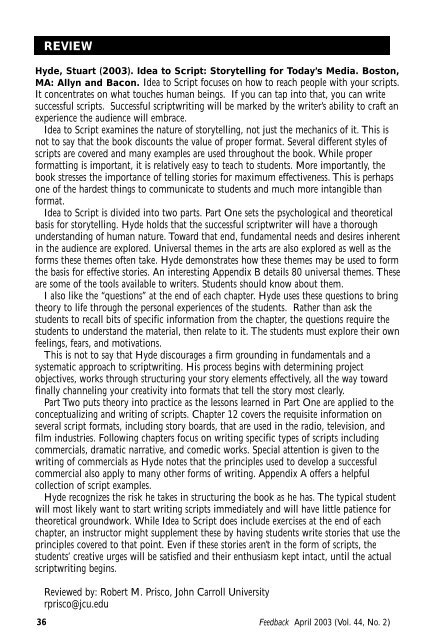APRILFeedback
Feedback April 2003 (Vol. 44, No. 2) - Broadcast Education ...
Feedback April 2003 (Vol. 44, No. 2) - Broadcast Education ...
- No tags were found...
Create successful ePaper yourself
Turn your PDF publications into a flip-book with our unique Google optimized e-Paper software.
REVIEWHyde, Stuart (2003). Idea to Script: Storytelling for Today’s Media. Boston,MA: Allyn and Bacon. Idea to Script focuses on how to reach people with your scripts.It concentrates on what touches human beings. If you can tap into that, you can writesuccessful scripts. Successful scriptwriting will be marked by the writer’s ability to craft anexperience the audience will embrace.Idea to Script examines the nature of storytelling, not just the mechanics of it. This isnot to say that the book discounts the value of proper format. Several different styles ofscripts are covered and many examples are used throughout the book. While properformatting is important, it is relatively easy to teach to students. More importantly, thebook stresses the importance of telling stories for maximum effectiveness. This is perhapsone of the hardest things to communicate to students and much more intangible thanformat.Idea to Script is divided into two parts. Part One sets the psychological and theoreticalbasis for storytelling. Hyde holds that the successful scriptwriter will have a thoroughunderstanding of human nature. Toward that end, fundamental needs and desires inherentin the audience are explored. Universal themes in the arts are also explored as well as theforms these themes often take. Hyde demonstrates how these themes may be used to formthe basis for effective stories. An interesting Appendix B details 80 universal themes. Theseare some of the tools available to writers. Students should know about them.I also like the “questions” at the end of each chapter. Hyde uses these questions to bringtheory to life through the personal experiences of the students. Rather than ask thestudents to recall bits of specific information from the chapter, the questions require thestudents to understand the material, then relate to it. The students must explore their ownfeelings, fears, and motivations.This is not to say that Hyde discourages a firm grounding in fundamentals and asystematic approach to scriptwriting. His process begins with determining projectobjectives, works through structuring your story elements effectively, all the way towardfinally channeling your creativity into formats that tell the story most clearly.Part Two puts theory into practice as the lessons learned in Part One are applied to theconceptualizing and writing of scripts. Chapter 12 covers the requisite information onseveral script formats, including story boards, that are used in the radio, television, andfilm industries. Following chapters focus on writing specific types of scripts includingcommercials, dramatic narrative, and comedic works. Special attention is given to thewriting of commercials as Hyde notes that the principles used to develop a successfulcommercial also apply to many other forms of writing. Appendix A offers a helpfulcollection of script examples.Hyde recognizes the risk he takes in structuring the book as he has. The typical studentwill most likely want to start writing scripts immediately and will have little patience fortheoretical groundwork. While Idea to Script does include exercises at the end of eachchapter, an instructor might supplement these by having students write stories that use theprinciples covered to that point. Even if these stories aren’t in the form of scripts, thestudents’ creative urges will be satisfied and their enthusiasm kept intact, until the actualscriptwriting begins.Reviewed by: Robert M. Prisco, John Carroll Universityrprisco@jcu.edu36Feedback April 2003 (Vol. 44, No. 2)
















